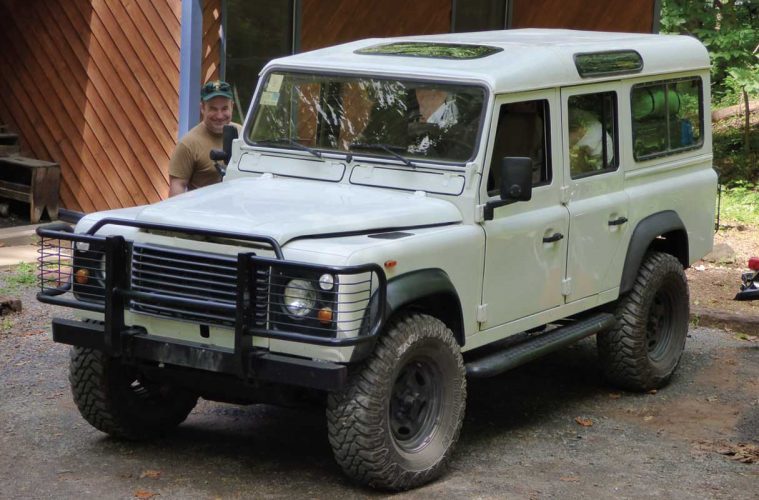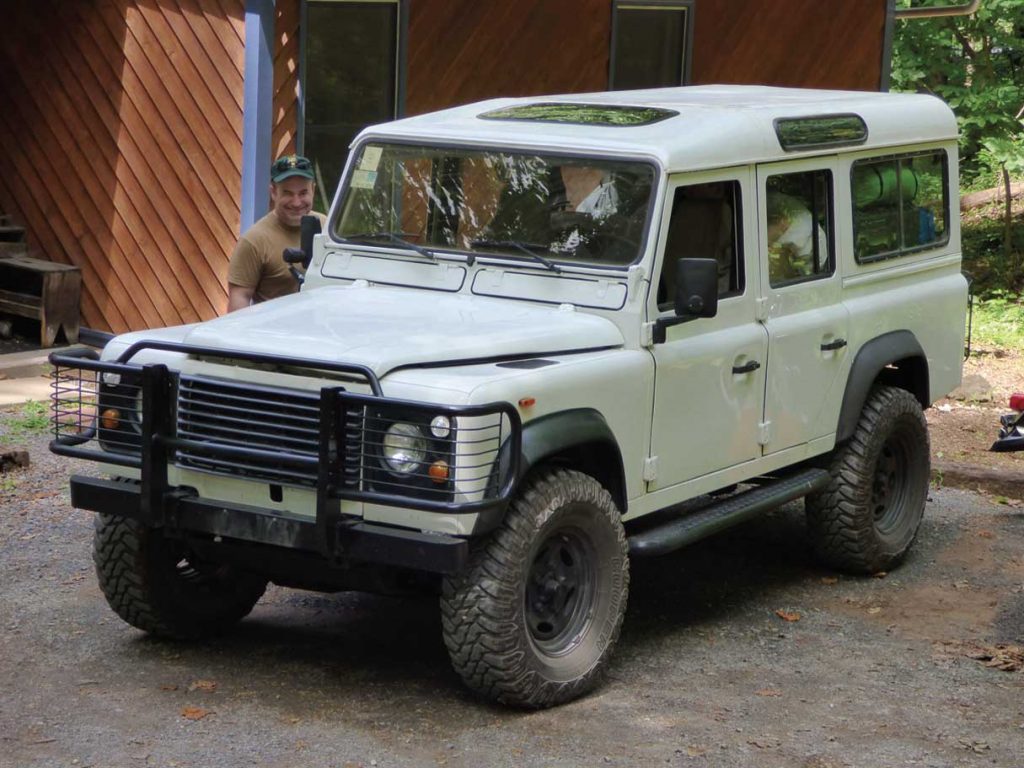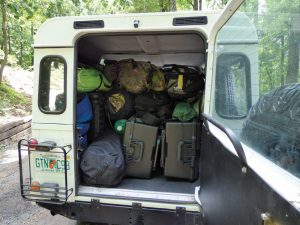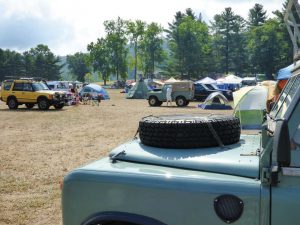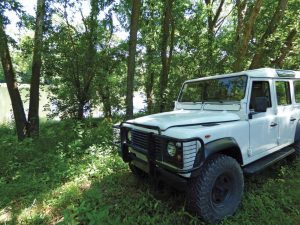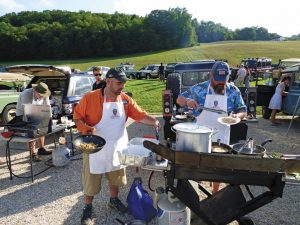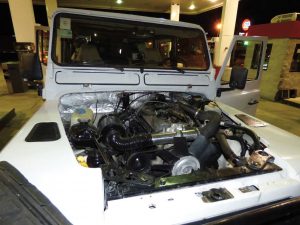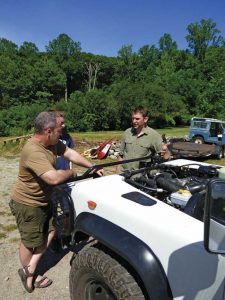[Yorkshire native Sam Watson splits his time between Jolly Olde and Egypt, overlanding in either “Elsa,” a Defender 110, or “Tasker,” a Discovery II Tdi. He’s a regular contributor to British Land Rover publications and when we met him at the Muddy Chef Challenge this summer we asked him to share his recent North American experiences -ed.]
It all started with a conversation in the Cambodian jungle. “Why don’t we drive the Defender across America?” asked Karl, my US State Department buddy, one morning as we waited for the monsoon to stop. At the time we were exploring the rainforests with three Defenders, and one of them, Karl’s truck, was to be shipped back to the US. It seemed like a great plan—Portland, Maine, to Portland, Oregon, and then to the Rubicon and Moab. We set to work.
The first hurdle was shipping the Landy stateside. The wagon, called “Penny”, had an interesting history. Karl and I had met in Cairo, Egypt, where he stumbled across the workshop of our gang of expatriate, Land Rover-loving Sahara junkies named the “Sand Rovers”. He’d asked whether we knew of any Defenders for sale; we did know of one, an ‘89 Land Rover 110, owned by a Cairo-based Texan, Gary. The original 2.5 petrol had been replaced by a 3.9 V-8. It needed a major rebuild to get it to ‘original spec’ to bring it to the US, including the necessity to replace much of the bodywork, which had been locally replaced with steel copies of the originals.
There are both pros and cons with rebuilding a vehicle in the Third World—on the one hand, the costs of bodywork are relatively low, but the quality of mechanical work is often substandard. For example, a workshop in backstreet Cairo cut and shaped aluminum sheeting, using hand tools and an upholsterer’s jig, into exact copies of the original Defender bodywork for a fraction of the cost of equivalent work in the US. The quality of the engine rebuild, however, was less than we hoped—but at least it ran. The plan was the 4-cylinder would get the car into a Cambodian shipping container, out of the container in the US, through Customs and as far as a garage. Karl would then drop her transplanted V8 in for our transcontinental trip.
Tense months followed, with emails flying between Karl in Cambodia, myself in Egypt and equipment sellers in the US and UK as we tried to return Penny to a Customs-acceptable specification. Rovers North was, predictably, hugely helpful; Greg Jutris was tireless in his supply of advice, humor and useful bits and pieces. In the end, Penny was shuffled into her metal box for the long sail to the US. We crossed our fingers.
Weeks passed, and then the news broke that the ship had docked on the East Coast. Penny sat at the mercy of Customs scrutineering. Karl had gone to great effort to make the old truck legal for US importation. Our worry was for naught. The guys at Customs behaved professionally and fairly, and we registered Penny without further delay. But where was the V8? The idea was that it would be shipped alongside Penny and replaced in the beast in time for the trip from Portland to Portland. A problem. Cambodian port officials had been expecting a bribe to ship engine and Land Rover together. The State Department, obviously, does not do bribes—so, no V8. Frenzied activity got the engine into another container and on its way, but too late for our plans.
So Penny was in, registered and on the road, but with a substandard Egypt-rebuilt engine that we knew would cause trouble. I flew to Washington, via a quick stopover at the family home in Britain, where I passed my own Defender 110 and Discovery 2 through the UK’s statutory, annual roadworthiness tests. At Dulles Airport I found Karl and his son, Ian, waiting for me with Penny. She looked good—gleaming Chawton White paintwork, 285 Cooper tires on Disco 1 rims, seats, headlinings redone in Egypt, the whole nine yards. We set off for a buddy’s cabin in the Virginia forests with high hopes.
The next morning began well. We set off for Maine. Penny drove enthusiastically, cruising at 65mph where laws permitted, even with three of us plus gear and the huge tires. We were daring to think we might pull it off, but Murphy was riding shotgun.
We rumbled through New Jersey at 10 pm when the hood flew off. The Egyptian rebuild had a flaw, specifically the hood-locking mechanism. Not only did the thing fly open and tear itself off, but it flipped over and came down on the roof of the truck, shattering the sunroof and covering the three of us with glass shards. The slipstream then carried the hood through the air, over the carriageway fencing and into a river. Dusting ourselves down we carried on—the plan was to get some photos of the Defender by night in Times Square and we ticked that box, much to the amusement of the NYPD, who gave the car admiring nods ’til they spotted the lack of hood—then their eyes widened to golfball size. A gang of girls on Broadway cheered when they saw Penny and one shouted, “Hey check out the Crocodile Dundee car!” Sadly, our timetable prevented us from sharing our Land Rover with the gang.
We reached Maine at crazy o’clock that night, and after touching base with old friend Mike and ‘Shorty’, his Defender 90, over half a dozen fresh Maine lobsters, we carried on westward. As we rolled into Vermont we ran out of fuel (the Cairo-fixed fuel gauge wasn’t working), and hitched into a town to fill a can. All the North African crud from the bottom of the fuel tank clogged up the fuel system and she ran raggedly into Canada.
There we met up with Patrick Findlay and the Ottawa Valley Land Rover Club for some off-road exploration of the northern forests. In the mean time, Joseph Sfeir, their ace mechanic, got busy with Penny’s engine and diagnosed carburetor and fuel-feed problems. On we went, after a fantastic couple of days in the wild forests. A monstrous 30-hour drive followed, fuelled by Red Bull and beef jerky, as we tried to make up for lost time. In Decorah, Iowa, things fell apart again—a mix of ignition, fuel supply and electrical system problems. Maybe Egyptians can build pyramids, but Land Rover engine systems seem off the menu.
Frustrated by the whole experience, Karl decided to halt the trip in Decorah and await the arrival and fitment of the V-8. We had to rein things in there and hang our boots up. As a Brit and a first time visitor to North America, I’d been hugely taken by the massive welcome I’d received and the friendliness of complete strangers. In the UK we think of you folks ‘across the pond’ as family, with ties of blood, history and culture that run deep, but I never expected to feel that link as strongly as I did on this trip. Needless to say, like everywhere else in the world, the Brotherhood of the Green Oval is a stronger bond still, with Land Rover enthusiasts building friendships that last a lifetime, just like our rigs.
In some ways the trip proved a nightmare of bad preparation and planning, yet in other ways, it was a huge success—the gaining of many new friends and a first view of the rich palette of colours and experiences that comprise the beautiful continent of North America.
Story and Photography By Sam Watson
